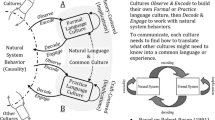Abstract
In today’s uncertain and unpredictable society, known as the VUCA era, the world is facing at the frequent occurrence of severe disasters caused by huge typhoons and torrential rains due to global warming, the global COVID-19 pandemic, the UK’s withdrawal from the EU, and the trade friction and struggle for supremacy between the US and China, in addition to such large-scale complex global problems, we are surrounded by so-called “wicked problems” that are difficult to solve, for which there may or may not be a single correct answer.
To what extent is science effective in solving these “wicked problems”? What can complement traditional science, which has focused mainly on “nature”, to solve the “wicked problems” facing humanity? This is the question we will consider in this essay.
I believe that we can solve the “wicked problems” by complementing the “science” base with an empathy-based approach from the perspective of “design”.
Our approach starts from the “wicked problems” of people, organisations and societies, clarify the current situation based on empathy, conceive an artificial system to support change it into a desirable future, create a blueprint, implement it in society in cooperation with engineering and administration, and then make the solution sustainable.
This approach is a combination of a general systems development approach and design thinking. In this chapter, we discuss the background to this approach.
First, I will summarise what the concept of “wicked problems” is, then I will clarify the author’s position on “science”, and then I will trace the evolution of systems theory as a complement to it. Finally, the importance of empathy as an “alpha” that should be added to science for solving wicked problems is discussed, after showing how it is linked to “design”.
Access this chapter
Tax calculation will be finalised at checkout
Purchases are for personal use only
Similar content being viewed by others
References
Ampère, A.-M. (1834). Essai sur la philosophie des sciences. Chez Bachelier.
Buchanan, R. (1992). Wicked problems in design thinking. Design Issues, 8(2), 5–21.
Bucolo, S. (2015). Are we there yet? Insight on how to lead by design. BIS Publishers.
Camillus, J. C. (2008). Strategy as a wicked problem. Harvard Business Review, 86(5), 98–101.
Checkland, P. (1981). Systems thinking, systems practice. Wiley.
Checkland, P., & Holwell, S. (1998). Information, systems and information systems. Wiley.
Checkland, P. (1991). From framework through experience to learning: The essential nature of action research. In H.-E. Nissen, H. K. Klein, & R. Hirshheim (Eds.), Information systems research: Contemporary approaches and emergent traditions. Elsevier.
Churchman, C. W. (1967). Wicked problems. Management Science, 14(4), B-141–B-142.
Conklin, J. (2009). Building shared understanding of wicked problems. Rotman Magazine, Winter, 17–20.
Danish Design Center. (2001). Retrieved from https://issuu.com/dansk_design_center/docs/design-ladder_en
Dietz, J., & Mulder, H. (2020). Enterprise ontology. Springer.
Graetzer, G. (1968). Universal Algebra. D. van Nostrand.
Jakobson, R. O. (2003). Les Fondations du langage. Essais de linguistique générale I.
Lévi-Strauss, C. (1967). Les Structures E‘le’mentaires de la Parente. Mouton & Co and Maison des Science de l’Homme.
Lee, S., & Kiesler, S. (1992). Connections: New ways of working in the networked organization. The MIT Press.
Maruyama, M. (1963). The second cybernetics: Deviation-amplifying mutual c ausal processes. American Scientist, 51(2), 164–179.
Meadows, D. H., Meadows, D. L., Randers, J., & Behrens, W. W., III. (1972). The limit of growth. Potomac Associates, Universe Books.
Mesarovic, M., & Pestel, E. (1974). Mankind at the turning point: The second report to the Club of Rome. Dutton.
Mesarovic, M. D., & Takahara, Y. (1989). Abstract systems theory (Lecture Notes in Control and Information Sciences). Springer.
Pettigrew, D. K., Thurgood, C., & Bucolo, S. (2016). A design innovation adoption tool for SMEs. In 20th DMI: Academic design management conference inflection point: Design research meets design practice.
Rittel, H. W. J., & Webber, M. M. (1973). Dilemmas in a general theory of planning. Policy Sciences, 4, 155–169.
Roman Osipovich Jakobson. (2003). Les Fondations du langage. Essais de linguistique générale I.
Simon, H. A. (1996). The sciences of the artificial (3rd ed.). The MIT Press.
Sproull, L. & Kiesler, S. (1992). Connections: New Ways of Working in the Networked Organization, The MIT Press.
Sterman, J. D. (2000). Business dynamics-systems thinking and modeling for a complex world. Irwin McGraw-Hill.
Suppe, F. (1977). The Structure of Scientific Theories. University of Illinois Press.
Toda, Y., & Iijima, J. (2000). Business process modelling (in Japanese). Nikka-Giren Syuppansya.
von Bertalanffy, L. (1968). General system theory. George Braziller.
Wiener, N. (1948). Cybernetics: Or control and communication in the animal and the machine. Wiley.
Author information
Authors and Affiliations
Corresponding author
Editor information
Editors and Affiliations
Rights and permissions
Copyright information
© 2022 The Author(s), under exclusive licence to Springer Nature Singapore Pte Ltd.
About this chapter
Cite this chapter
Iijima, J. (2022). What Should Be Added to Science for Solving Wicked Problems?. In: Kijima, K., Iijima, J., Sato, R., Deguchi, H., Nakano, B. (eds) Systems Research II. Translational Systems Sciences, vol 27. Springer, Singapore. https://doi.org/10.1007/978-981-16-9941-2_7
Download citation
DOI: https://doi.org/10.1007/978-981-16-9941-2_7
Published:
Publisher Name: Springer, Singapore
Print ISBN: 978-981-16-9940-5
Online ISBN: 978-981-16-9941-2
eBook Packages: Business and ManagementBusiness and Management (R0)




